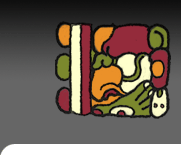 |
 |
 |

| Though the ancient Maya developed a unique solar calendar called the Haab, they also followed the rest of Mesoamerica in using Year Bearers to define and name individual solar, 365-day years. The Year Bearers are derived from the 260-day cycle, 4 day names that are consistently hit if one runs the 260-day cycle through 365 days. The mathematics run like this:
Of the two options, the modern Maya of Guatemala who still keep the calendar follow the GMT. Out of respect for living tradition, the dates presented in this website also follow the original GMT.
260 days + 105 more days = 365 days
105 days ÷ 20 day names = 5 full rounds and 5 more days remainder It is that five remainder days that will always arrive at only one of four day names. For the modern Maya of the Guatemala highlands, those four days are:
The Year Bearers run in a cycle of 52 years. If one year is 1 Ik', then the next will be 2 Eb', the next 3 Kaban, the next 4 Manik, the next 5 Ik', and so on for 52 solar years until it arrives back to 1 Ik'. Each of these four years have their own character. Their individual characters are further defined by their number coefficient. For example, a 1 Ik' has a weak version of Ik' year traits, 7 Ik' is balanced, and 13 Ik' is very strongly Ik' in character. Here are the characters of the four Guatemalan Highland Year Bearers:
Ik' A bold year, hard times. Either floods or no rain at all. Natural disasters and starvation. Eb' A quiet, calm, enduring year. A good year for business and health. Kaban A year of creativity and ideas, both good and evil. Manik' A turbulent year, one of business losses and illness. In the highlands, these four are called the Mam, the ancient spirits of the Earth. Each takes their consecutive terms characterizing the year. Also, the year bearer during which one was born affects their personal character and destiny. The five days before the new Mam takes its turn are considered dangerous days, not for any important social or business activities. This very nicely matches the Wayeb, the last five days of the Haab calendar, also said to be dangerous, unpredictable times. The first twenty days of the year, until the Year Bearer's day sign occurs again, are times to abstain from sex and green vegetables, both of which are thought to make one weak. Burning ceremonies and fireworks celebrate the end of those first twenty days. What is odd and confusing is the fact that different regions and time periods in Mesoamerica name different day signs as the Year Bearers. For the Aztecs, Mixtecs, and Zapotecs at the Contact Period, the four Year Bearers were:
But during the same Contact Period, Diego de Landa recorded a different set for the Maya people of Yucatan:
Landa confirmed that information through multiple contexts and there is no reason to disbelieve it. However, the Year Bearers as written in the Maya codices and Classic Period hieroglyphic texts are not Landa's four, but rather the same one's used in Central Mexico:
Why are there differences, and why do the four used by modern Maya of the Guatemalan Highlands match neither the ancient or Contact Period Year Bearers? Again, here they are:
Thompson (1960: 127) concluded: "On the assumption that the Akbal set was used by most cities of the southern area, the Yucatec system can be explained satisfactorily. It is now known that the Maya of Campeche, at least as early as 9.12.0.0.0 changed the month positions on which the day Ahau fell, so that under the new arrangement the end of Katun 12 was not 10 Ahau 8 Yaxkin, but 10 Ahau 7 Yaxkin. The days remained unchanged; the month positions advanced one place. Similarly, Kan, Muluc, Ix, and Cauac had perforce to fall on the first of Pop in place of Akbal, Lamat, Ben, and Etz'nab. Why this shift took place we do not know, but that it did take place without loss of a day is now established." Later in the same passage, Thompson writes: "The Quiche and Ixil, with no stela cult and, apparently, no LC, might have had little interest in keeping those two ceremonies apart, and in time the days on which the years were seated might have acquired more importance, and finally replaced the next group of days as bearers of the years." |


